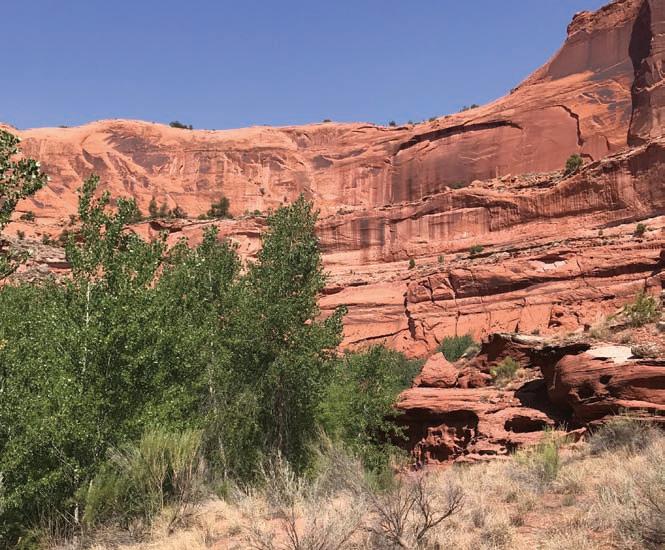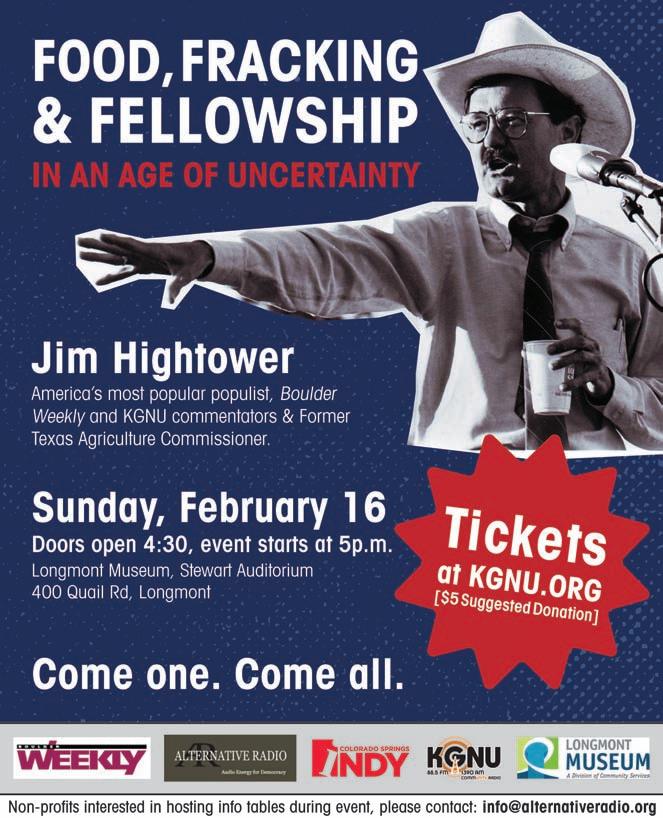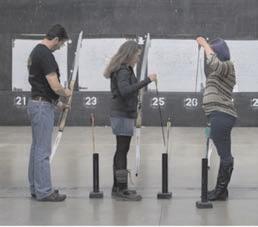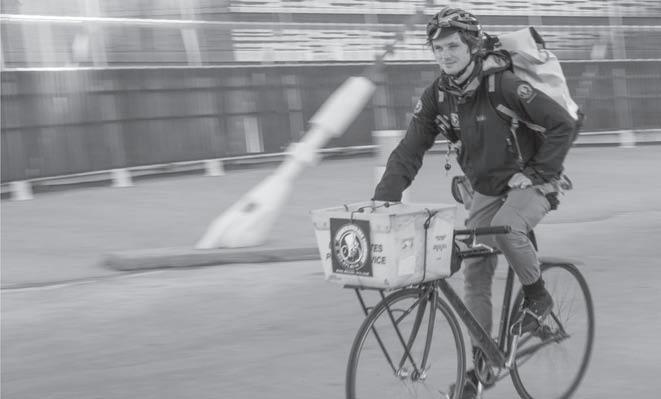
58 minute read
Letters: Signed, sealed, delivered, your views
On national park funding
Colorado’s national parks are seeing record visitation, but unreliable funding over the years means their infrastructure desperately needs to be repaired.
Advertisement
That’s why I am encouraged by a bipartisan proposal in Congress to address the nearly $12 billion in national parks deferred maintenance. The Restore Our Parks Act (ROPA) would set aside $6.5 billion over the next five years to fix dilapidated trails, buildings, roads, bridges, monuments and historic markers in our parks. Amazingly, 50 U.S. senators — from both parties — are cosponsoring this effort, with 330 representatives supporting a similar measure in the House.
With all this support, you would think this would be an easy thing for Congress to get done. You’d be mistaken. Despite all the support for national parks, Congress is still struggling to enact this popular legislation. There is still time, and I hope they can get it done. Sens. Gardner and Bennet are both cosponsors of the ROPA, and Gardner especially is in a key position of leadership to help bring the bill to a vote. We need to see action to ensure our parks stay open, safe and accessible. Please do the right thing in supporting this crucial legislation.
Ryan Fitzgerald/Wheat Ridge
Done with the Super Bowl
While watching the Super Bowl, I came to a realization: this whole thing is disgusting. I finished the game but drifted off to sleep that night with a sick feeling in my gut. Hours later I awoke in a sweat, realizing I had just witnessed a concerted effort to melt the minds of the American public. In my head I catalogued what I had just seen: The U.S. military using the biggest sporting event of the year as a recruiting tool, dozens of grown men willingly and repeatedly giving themselves brain trauma so that they may receive vast sums of money for moving an egg-shaped leather ball over a white line, Verizon ads praising first responders (let’s not forget that Verizon throttled fire fighters’ unlimited data during a 2018 California fire and avoided $21.1 billion in federal taxes between 2007-2015), Google ads, Facebook ads, political ads... the list goes on. I even caught a glimpse of the architect of it all, the shadowy figure of Rupert Murdoch sitting next to his fourth wife. He was trying to fit in to the crowd but the seats around the two were empty, perhaps the flock of sheep could sense a wolf among them.
It was enough to force me back to bed to escape the nightmare of reali
ty. I’ve been trying to tell myself it was just a bad dream ever since... Anyway, can’t wait for next year’s game!
Will Chaney/Boulder
see LETTERS Page 9
Turn Your Miles Into Smiles

Donate Your Miles Credit to One of Three Charities at Checkout.







I closed a few abandoned wells last year, reportedly at an average cost of over $200,000 apiece. Recently, one well in Canada cost about $5 million to close. We recommended the money generated from this tax money be deposited in a trust fund to cover all future closing costs of old wells that are abandoned or need rehabbing. Engineering studies show wells have to be reclosed on an average of every 20 years — cement breaks down and steel corrodes. The legislation called for the establishment of a state green bank to hold and loan these monies out for green projects within the state until needed for well closing.
We also recommended that the tax exemption for small producing wells, called stripper wells, be eliminated. Last week, Czar Robbins announced that about 88% of all wells in the state were now stripper wells. By definition they are wells that produce fewer than 15 barrels of oil or 90,000 cubic feet of gas on a daily average over the course of a year. There is much room for gaming in such a formula.
Given present oil and gas prices each stripper well could theoretically produce gross revenues in the $300,000 range, provided production for both oil and gas was at the legal maximum for a stripper well. Add to this that the state does not aggregate these wells for tax assessment purpos- es. Thus, if Noble, out of its 7,000 wells, had even 50% that were strip- pers that were producing gross reve- nue of $300,000 each, that would amount to over $1 billion in gross rev- enue that was escaping just taxation. See if you can get this deal. You don’t pay any income tax on your first $300,000 of income. Your wife can even make $300,000, as can each of your four children through a trust, and none of it is taxed. Only the value of your property would be taxed. Wait for the look of disbelief on the tax man’s face if you even dared trot out such a proposal.
Thinking even bigger about the larceny afoot, if 88% of the wells in the state are stripper wells as Czar Robbins declares, all producing to their maximum, and the inventory of all producing wells is 40,000, then the theoretical gross revenues escaping any state taxation might total about $10.6 billion annually.
Our legislation would have stopped any severance tax from going back to the counties of origin or to the state water fund. Yes, some of the severance tax goes to keep water buffalo fantasies alive at public expense.
Local governments already tax the industry. Weld County, for instance a few years back, collected about $500 million from the industry in property taxes. The state collected about $45 million in severance tax that year.
State law allows the industry to deduct most of these local property tax payments from their state sever- ance tax bill. As a result, oil producers in Weld County have paid nothing in state severance taxes in some years; yet, the county always received sever- ance tax returns from the state.
We brought this legislation to the attention of certain legislators in 2018. It was not welcome. The excuse then was SB 19-181 was being pushed, and there was no room for more environmental lawmaking. Had the law been in effect last year and this, perhaps as much as $1 billion would have been deposited in the state trust fund. The estimated cost of closing and maintaining wells aban- doned by bankrupt frackers is in the many billions.
Now the excuse at the legislature is that the public would never support it. Since the bill is a tax increase, it would have to be referred to the pub- lic for approval on the ballot. This excuse may have more to do with the Democratic leadership’s blind hate of TABOR as destructive of good gov- ernment than it does with public approval. Everybody hates being taken for a ride, but people won’t know about the ride their being take on, for it’s a figurative one, unless you tell them and provide a remedy.
Perhaps, the Solons at Colfax and Broadway need a little fireside chat with FDR so they could be reminded that the only thing they have to fear is fear itself — and that the state could achieve insolvency if something seri- ous isn’t done to protect the public from the prospect that many of the frackers will go belly up and leave their poisonous legacy behind for future generations to manage.
Lord Acton, often quoted, said, power corrupts, and absolute power corrupts absolutely. The oil industry is in the absolute quadrant, with much assistance from state government.
This opinion column does not necessari- ly reflect the views of Boulder Weekly.
Taking the Fifth
While there is much discussion over the Second Amendment and the rights and limits of gun ownership, we hear less and less about the Fifth, which states that a person sworn under oath to tell the truth is allowed to not answer self-incriminating questions. Underlying this right is a profound respect for both a sworn oath and truth saying. Given the seemingly decaying value of truth in public and political life today, one wishes that all those sworn to uphold the Constitution would take the Fifth rather than proclaiming outright lies. Robert Porath/Boulder
Hold oil and gas accountable
The public learned recently that more than 75% of the oil and gas companies operating in Colorado have failed to submit more than 50,000 legally required monthly reports and, in so doing, knowingly cheated Colorado out of millions of dollars in owed taxes. We also learned that the equipment used to measure oil and gas production was not inspected to ensure accurate readings, likely causing a further under-reporting of output and underpayment of taxes. And to add insult to injury, this systematic fraud has been going on for years and the state regulatory agencies didn’t even realize it.
Why are these oil and gas companies not held to account like citizen taxpayers are? If a citizen does not file a required tax return and does not pay the taxes that are owed, the citizen has to pay back taxes, additional penalties and can go to jail. The same rules should apply to oil and gas companies. This industry has purposefully swindled the Colorado government and should not be excused from paying the taxes they owe, plus penalties accrued. The IRS does not forgive even honest mistakes like typos, why should the Colorado people let oil and gas corporations off the hook for this deliberate and longstanding cheating?
Clearly, this is not a problem that just started in the last two years. The audit only checked the last two years, so this non-compliance and tax evasion has likely been going on since the industry started operations here. Claiming that the statute of limitations has run out and that there is no way to punish the oil and gas companies for perpetuating this fraud is pitifully weak. Colorado is sending the message that it is OK to cheat and steal from us. Don’t ever again let these oil and gas companies brag about how much tax revenue they pay towards supporting schools and our communities. This industry has not been paying their share for years and yet they use these same arguments against us when they claim that strengthening safety regulations and increasing severance taxes (closer to what other states require) would put them out of business. That is hubris on a massive scale.
Caught red-handed, the oil and gas industry now blames the COGCC for not noticing that the industry was hoodwinking them and cheating on its taxes. We must not allow the industry to shift the blame for their own deliberate criminal activity. However, it is astoundingly egregious that the COGCC has for years, failed to enforce its own reporting rules. That is the purpose of this regulatory agency. The COGCC itself should be punished for not doing its job and allowing many millions of severance dollars to go uncollected. The COGCC’s shoddy operations and lack of understanding of their own responsibilities makes it impossible to trust them to do all of their other vital regulatory functions. Why should we trust the COGCC with the far more difficult task of protecting Coloradans’ health and safety when they have such huge procedural lapses in their basic duty of collecting and tracking paperwork?
The solution to this problem is not (as the COGCC has promised) to tweak some algorithms and hope that everyone forgets what happened. At the very least, we should require the oil and gas companies to pay their back taxes owed from the last two years covered by the audit and we should enforce the $200 per well, per day fine that these companies incurred. A punishment even more fitting for the crime would be to also prohibit these non-compliant compa nies from ever again doing business in our state. And going forward, the state legislature must act to ensure that the regulatory agencies enforce the laws already on the books and must impose stricter controls on the corrupt and untrustworthy oil and gas industry. Megan Wilder/Boulder
25% OFF the purchase of a Big Daddy Club Mug, & get FREE COFFEE REFILLS EVERY MONDAY WITH THE MUG

GOLDEN on Route 93 303.279.1481 BOULDER at Meadows Shopping Center 303.554.0193
Expires 2/29/20
Authentic NYC BAGELS in Colorado
LAFAYETTE 489 US Highway 287 303.665.5918 LONGMONT Prospect Village 1940 Ionosphere, Ste. D 303.834.8237
KIDS FUN & CAMP DIRECTORY Boulder County’s most comprehensive listings and directory for children’s activities and camp fun.
Coming Thursday February 20th
303.494.5511 advertising@boulderweekly.com
Ten $5,000 scholarships available for Spring 2020 incoming class
SouthweSt Acupuncture college Boulder • SAnte Fe
the Future oF Medicine iS wAiting For You!
Flexible online classes embedded within an accredited Master’s residential program

Spring 2020 transfer students receive 10% discount on first semester tuition
www.acupuncturecollege.edu • 303.581.9955
Realign your body. Move with ease. FEEL BETTER.
START THE NEW YEAR OFF RIGHT WITH ROLFING ®
1290 Yellow Pine Ave. Boulder, CO 80304

720-878-2888 GETROLFING.COM
ICE detaining transgender individuals despite widespread calls for their release by Angela K. Evans

LGBTQ AND MIGRANT RIGHTS activists block an intersection in Albuquerque, New Mexico, in August 2018 to demand justice for for a trans woman who died from medical issues gained during her time in detention.
In Estella’s home country of Cuba, transphobia is rampant, she says. She’s been attacked. She’s been targeted by police. There are no human rights, she says. There is no access to HIV medication.
“I preferred to risk my life than continue that way,” she says through her lawyer at the Rocky Mountain Immigrant Advocacy Network (RMIAN). Estella is a pseudonym. She, like many within the transgender community currently detained at the Immigration and Customs Enforcement (ICE) Aurora Contract Detention Facility operated by the GEO Group, Inc., is hesitant to share personal details about where she’s from or the situation that led her to flee to the U.S. Like many transgender people seeking asylum in the U.S. she fled violent transphobia in her home country only to be prolongly detained by ICE in a system, advocates claim, illequipped to provide for their specific needs and care.
Being in detention is “dreadful, ugly,” Estella says, according to her lawyer. “We are here asking for asylum and they’re treating us badly. Some of the officers treat us like
10 I men. They have a phobia. It’s more of a problem with the women.”
Estella says that being in detention has affected her physically, mentally, emotionally — “Daily and completely, in every sense of the word.” And she’s not alone. Although the Aurora facility has housed transgender people for some time, the numbers have steadily been increasing since 2019, says Laura Lunn, detention program managing attorney at RMIAN. Then, on Jan. 21, the facility’s trans population more than doubled when several trans individuals were transferred from a correctional facility in New Mexico. The Aurora facility is currently housing about two dozen trans individuals.
This number may fall short, however, Lunn says, given that it often takes weeks or even months for lawyers to fully understand how a person identifies, leaving many people without specific services at all.
“Sometimes people themselves don’t have the vocabulary to describe how they identify in a way that resonates with us here in the United States,” she says. “So my guess is that a lot of people who are identified as male or female may not actually fall into one of those two boxes so easily and that a lot of that information is not being properly captured through the current process that is in place.” According to a Jan. 27 accountability report from U.S. Rep. Jason Crow (D-Aurora), the transgender
FEBRUARY 13, 2020 individuals at the Aurora GEO facility are being held in three different dorms, at least one of which is a dedicated trans dorm. There is no dedicated medical personnel for this specific population, so, for now, ICE and GEO are working with the Denver Health LGBT Center for Excellence to provide both oversight and care of the mostly trans women currently being detained.
Many of them require hormone therapy, some of them are HIV positive. Others don’t know their HIV status and would benefit from a test. All of them require specialized mental health care, Lunn says.
“Transgender people who are detained have a lot of needs just because there is a mixture of trauma history that is particularly pertinent in these types of cases, and then on top of that most people have profound medical needs,” Lunn says. “Beyond what it means to be detained as a baseline, it is particularly complicated when you have specific social and medical needs.”
In Lunn’s estimation, the best solution is releasing transgender people so that they can have ready access to care whenever it’s required. It’s an opinion shared by many within the immigrant advocacy community, as well as Democratic members of Congress who are working to ensure extra protections for detained transgender individuals.
• • • •
Most of the trans women now being held in Aurora came from the Cibola County Correctional Center in Milan, New Mexico, about 90 miles west of Albuquerque. The trans-specific unit in Cibola was opened in the summer of 2017, after a similar unit was closed in Southern California, and ICE has detained hundreds of transgender and gender nonconforming individuals since.
But claims of inadequate medical neglect, lack of mental health care and the use of solitary confinement (administrative segregation, according to ICE) are common, according to the Santa Fe Dreamers Project, a legal advocacy group that has represented about 200 trans women across the country. On Jan. 21, dozens of individuals were unexpectedly transferred out of Cibola, and the unit effectively closed.
Allegra Love, executive director of Sante Fe Dreamers Project, estimates about 95% or so of the women are from El Salvador, Guatemala, Honduras and Mexico, although there are occasionally women from elsewhere, like Eastern Europe and Jamaica, for example.
“They’re facing direct violence from their families, direct violence from their neighbors and their communities, direct violence from law enforcement,” Love says. “We’re talking about deadly transphobia, not just it’s hard to get a job, not just feeling rejected by your society, but your life
is in danger when you step out on the streets.”
But the conditions of detention in the U.S. also present unique dangers and challenges for transgender people, Love says. Most of the time people are put into dorms according to their gender assigned at birth, creating dangerous situations of sexual harassment and assault. In 2017, LGBT individuals were victims of 12% of reported sexual assaults in ICE detention, according to the Center for American Progress, despite the fact that they accounted for only 0.1% of the overall detained population.
“They’re at risk for sexual assault, physical assault, for bullying, discrimination, and when they don’t want to be in that detention, what happens is they could get put into solitary confinement,” Love says. “And when they get pushed to the brink being in solitary, then their only choice is to go back into general pop and it’s really two torturous situations.”
Transgender folks also need specified medical attention and unique mental health care, which for the most part has been sub par at best at ICE facilities across the nation, Love says.
In the last two years, at least two trans women claiming asylum died in New Mexico. In the case of Roxsana Hernandez, a transgender woman from Honduras, an independent autopsy paid for by the Transgender Law Center revealed deep bruising, dehydration and complications resulting from untreated HIV. Hernandez was last held at Cibola before being transferred to an ICU at a nearby hospital, where she passed away less than a month after claiming asylum in the U.S. in 2018. About a year later, another trans woman, Johana Medina Leon from El Salvador, passed away four days after being released from the Otero County Processing Center, also in New Mexico.
In June 2019, about two dozen trans women at Cibola signed a letter claiming inadequate medical care and subjugation to psychological and verbal abuse by the guards.
“They treated us like men from the beginning,” says Jade, a transgender woman from Central America currently seeking asylum in the U.S. who was released from Cibola last year. “When I was asking for asylum in Tijuana they took away everything I used to express myself — the feminine things. They took away my hair extensions, my eyelash extensions and my clothes. And [the discrimination] was present during my entire journey.”
Jade, her chosen pseudonym, is only 22. She was kicked out of her house after finishing high school. During the day, she worked at a place where she had to keep her hair short for fear of losing her job. On weekends, she worked at a trans show, trying to make ends meet and afford her apartment.
“I didn’t have any support from my siblings, my family, my parents, nothing,” she says through an interpreter. “Everyone turned their backs on me in that moment.”
She began hormone therapy in secret as well, but quickly it became clear this life wasn’t sustainable. “Many of my friends where I lived have been killed,” she says. “It’s been women near and far to where I live, and especially during their transition process and those involved in activism supporting the trans community, they’ve lamentably been assassinated. And they are all innocent people.”
Jade traveled to Tijuana, crossed the border and claimed asylum with other trans companions she met along the way. When she first got to Cibola, she says she told officials she didn’t want to be housed with cisgender men. According to ICE, when a person doesn’t want to be held in
general population for whatever reason, administrative segregation is the only option. So Jade was put in a cell by herself, in “an area where there were people who weren’t right in the head,” she says. “The rest of my [trans] companions, they sent them to a cell where there were 40 men, I think, in a big dormitory, and 10 trans women, small chicas, they were sharing space with men and sharing the bathroom. It’s tough but that’s the truth.”
She calls what happened to her and other trans women at Cibola “a big injustice” and now works as an advocate for her community, making sure new arrivals have support and know they are not in it alone. • • • • In the wake of the deaths of Hernandez and Leon, as well as mounting complaints from current detainees, there has been a flurry of letters directed at ICE demanding that the agency release all trans men and women currently in detention unless it can adequately provide for their care. In recent weeks, Democratic members of Congress in both the House and the Senate, as well as more than 80 advocacy organizations, have signed onto letters addressed to Acting Secretary of the Department of Homeland Security, Chad Wolf, and Acting Director of ICE, Matt Albence, describing the extreme risks transgender individuals face around the world and in detention, and asking the agency to honor the reputaCOURTESY DIVERSIDAD SIN FRONTERAS In 2017, LGBT individuals were victims of 12% of reported sexual assaults in ICE detention ... despite the fact that they accounted for only 0.1% of the overall detained population. Roxsana Hernandez

tion of the U.S. as a place of refuge. What’s more, the letters point to specific direction from Congress, passed as part of the 2020 appropriations bill in December, that only allows the detention of transgender immigrants “in facilities specifically contracted for their care,” according to the office of Rep. Mike Quigley (D-Illinois). “Currently, no ICE facilities meet these standards,” the press release, dated Jan. 14, states. This language is based on a 2015 ICE directive that describes how the agency should accomodate transgender individuals in its care.
“This memo that ICE put out in 2015 recommends that facilities contracting with ICE, if they’re going to have transgender immigrants in their custody, adopt a formal contract modification,” says Heidi Altman, director of policy at the National Immigrant Justice Center. “And that’s important because contracts are what provide accountability in ICE’s current detention system. And so [a] facility may be providing X, Y and Z services right now, but if they’re not contractually obligated to do so, there’s nothing holding them to continuing to do so.”
Altman, like most others BW spoke with, advocates for a policy of supervised release for transgender individuals, since in almost all cases they don’t present a threat to national security or flight risk. They all, advocates say, have valid asylum claims and have a vested interest in showing up for court. What’s more, multiple studies show this population is particularly vulnerable in prison-like settings.
“If somebody doesn’t have any criminal history and they have an extremely strong likelihood of prevailing on their immigration case, one would think that the vast majority of them should be released from detention if not all of them,” Love says. “And especially given how risky it is to detain this population and how intensive their social and medical needs are, it just does not make sense.”
In Aurora, Crow’s report says GEO has reached out to community service providers to help with additional and specific mental health support for the transgender population. It also states that Crow’s staff will give GEO a list of community service prosee TRANS Page 15


The right to have rights In light of job vacancies and work-environment issues, new bill would allow Colorado public employees to collectively bargain by Matt Cortina
For the last eight years, Kristi Griffith has worked at the Colorado Department of Human Services (DHS) helping provide grants to organizations that work with children at risk of domestic violence, drug abuse, income insecurity and more. Her work, and the work done by the 4,000 other employees in DHS, provides a safety net for Colorado residents who encounter insecure and dangerous living situations.
But like many of her coworkers at DHS and the 28,000 other employees of the state, Griffith feels like she isn’t empowered to adequately voice her concerns about wages, work environment and workloads. That disempowerment, she says, has contributed to a 24% annual turnover rate in the department.
“I think people are frustrated with low pay and not getting paid when there are vacancies for doing extra jobs,” Griffith says. “If we have a high turnover rate, that means you have a high vacancy rate, which means you’re asked to take on additional duties, often doing two or three jobs for months at a time. The [state] hasn’t been great about differential pay ... it’s not something that’s offered very often.”
Griffith says many state employees are frequently asked to do more for less. And while new administrations and legislators vow to provide support, nothing seems to change.
“I think each administration seems to want to address it; they act like they do,” Griffith says. “We get employee surveys each change of administration, but we don’t see change happening. We get told they’re making changes, and we don’t see it happen.”
Thus, a new bill — the Colorado Partnership for Quality Jobs and Services Act — is circulating in the state legislature and would allow state public employees to unionize and collectively bargain. If passed, the Act would codify an executive order signed by former Gov. Bill Ritter that set the groundwork for state employees to have a union representative, but because it’s not a statute, could be revoked at any time by a future administration and legislature.
“Legislation is needed so that state employees’ right to collectively bargain is recognized and secured in our state’s laws,” says Rep. Daneya Esgar (D-Pueblo) who is sponsoring the bill. “While the state always has the best intentions, the people who know the work best are the employees on the frontline. Having a formalized way for their input about the jobs they do and the services they provide to be included in setting the course for state services will result in improvements all the way around.”
The key mechanism in the bill is a provision that allows employees to negotiate directly with the state through their union representation about wages, working conditions, benefits and more. It’s a change from the executive order, which didn’t bind the state to such negotiations.
“The executive order only allows for there to be partnership meetings, which is in essence a meet-and-confer without any legally binding requirement to do what was agreed upon on in the meeting,” says Hilary Glasgow, executive director of Colorado WINS, the state employee union. For instance, state Department of Corrections (DOC) employees recently stood before a state committee and described how understaffing and hazardous working conditions have contributed to a low employee retention rate in the department. With passage of the bill, Glasgow says, DOC employees will be able to sit down with department heads and the state to negotiate working condition standards — anything from uniforms and schedules to staffing and safety.
There is a no-strike clause in the bill, but Glasgow says that’s for good reason: “State employees do the critical background work of the state that can’t go undone. ... You can’t have no one show up to work at a prison.”
Glasgow adds that although striking may be used by other unions, it is usually done as a last resort. And Esgar says the bill has language that ensures the state “will act in good faith.”
“The state cannot refuse to participate in the partnership process, for example,” she says.
Opponents argue the bill would increase costs to the state, but proponents counter that the current cost of retraining individuals and paying overtime costs to fill the one out of five vacant public jobs is higher.
Ultimately the bill is about giving power to public employees, to promote direct action in response to their concerns.
“Bringing people to the table who do the work to have a voice on how the work is done and how it’s compensated… to have a discussion that both sides are bound to,” Glasgow says, “these things are not rocket science.”

1275 Sherman Dr. • Longmont CO • 303-443-5885

See why we’re consistently the TOP MOVER in Boulder County at TAYLORMOVE.COM
Licensed, Bonded & Insured • Locally Owned & Operated by the Taylor Family Call Today! 303-443-5885


TRUE LEARNING EDUCATIONAL SERVICES
Elevate your child’s confidence and academic skillset before the 2019-2020 school year! Our targeted, comprehensive interventions leverage your child’s strengths, while addressing areas for growth. Our expertise in special education enables us to successfully support children with mild-moderate autism, intellectual or learning disabilities, including dyslexia, as well as ADD/ADHD. Our process begins with a Personalized Education Game Plan that details your child’s strengths and areas for growth, which becomes the basis for a personalized set of goals to maximize his/her academic

potential both now and in the future. Clear action steps, coupled with personalized instruction and a timeline to attain all goals provides the foundation for enhanced success in the classroom. The plan also details recommended classroom adaptations and targeted academic activities to be completed at home. Weekly progress reports are provided to families. Our thorough, targeted process will provide your child with a competitive edge moving forward.
400 E. Simpson Street, Suite G02, Lafayette. 510-909-9939 info@truelearningeducation.com
Mind body neuro
Train your brain with Neurofeedback- for optimal learning, performance and healing - cutting edge brainwave technology promotes relaxation, concentration, focus and attention and decreases anxiety, reactivity and distractibility.
Neurofeedback changes timing and activation patterns in the brain, guides your brain back into normal, healthy ranges and reconnects neuron pathways. Your brain can then organize itself and release old patterns that get in the way of effective functioning. The result is an improvement in brain regulation and efficiency. Neurofeedback has proven effective for • Anxiety,

depression • Peak Performance • ADD & learning issues • Mood regulation * Focus and concentration • PTSD, Trauma • Concussion,TBI • Insomnia • Anger, social insecurity • Meditation • Stress • Addiction NeurOptimal® neurofeedback is like ‘defraging’ your hard drive - it’s suddenly easier to get out of your own way and access your best performance. Obstacles fall away and life seems more in flow. Experience your brain’s potential! Home rental units available. Contact Joy Om 303 449-8664, text 720 469-0164 mindbodyneurofeedback.com
Boulder Pet Doors
Your Pets Opening To Health & Happiness

To learn more visit: boulderpetdoors.com or call: 720-212-3111
Have you seen those television shows where people give away everything to move into a tiny house that’s 100 square feet with just enough room for two coffee cups and two spoons but no coffee maker? It would be so easy to move if all you owned were two coffee cups and two spoons… But, you probably own two and another eight. So when it comes time to pack it all up and move from one not-so-tiny house to another, you’ll probably want some extra hands. Call Taylor Moving and Storage when that time inevitably comes. They’re experienced and locally owned and operated, so they know how to heave your heaviest things and deliver them carefully to your next destination. Taylor Moving and Storage
Personalized Interventions and Targeted Transitional Services to Support K-12 Students in Reaching their Full Potential

FURNITURE COMES FULLY ASSEMBLED AND READY TO USE NEW ARRIVALS DAILY!

3550 Arapahoe Avenue • Boulder 303.440.9011 • usedfurnitureboulder.com Taylor Moving is the most awarded moving company in Boulder County! Thanks to its reputation for trustworthiness, superior service, and satisfied customers, Taylor Moving is Boulder County’s only moving company voted the best for more than 10 years in the Best of Boulder, from Boulder Weekly, the Daily Camera’s Boulder County Gold Awards, and the Times-Call Reader’s Choice awards. Taylor Moving specializes in moves within Boulder County, but is big enough to handle anything within the state whether it’s commercial or residential. Our family of experienced movers has been moving local families since 1997. Let our service move you!
taylormove.com. Call 303-443-5885

Discounts from 20% - 50% off! Save on local dining, entertainment, retail and wellness.

and more!
viders who may be able to help with additional services particular to this population. And the staff of both ICE and GEO, the report states, have had several recent specific training sessions for this population, although ICE was unable to provide any detail as to what that training entails by press time.
“I’ve been very impressed by the way that both ICE and GEO have responded to the increased transgender population at GEO,” Lunn says. “Based on our interactions they’re doing everything in their power to make sure that people’s needs are being met.”
Still, she points out that GEO’s medical staff does not include a specialist equipped to serve this population, although they have been working on it. Plus, the transfer to Aurora uprooted these women from a strong support system in New Mexico, one that had been developed over many months, even years, and placed them in a much larger prison-like context.
“It’s been divisive to the community that they had formed in New Mexico and with one another,” Lunn says. “While it’s very encouraging that they have broader access to medical care here in Colorado, it certainly has had damaging effects to the psyche.”
The women are getting ESL lessons twice a week, and the hair styling services already available in the women’s areas will now be offered in the transgender dorm, according to Crow’s report. But in New Mexico, community groups as well as the Transgender Resource Center provided weekly therapy sessions and makeup nights, Love says, forming bonds and a support system for many of the women. She too is hesitant to give ICE too much credit.
“I will say that ICE leaning on those things in an attempt to say that detention [is] humane is complete and total bullshit,” Love says.
Through RMIAN, every trans person currently at the Aurora facility is either represented by in-house staff counsel or pro bono attorneys. On Wednesday, Feb. 12, advocates and elected officials rallied at the Colorado State Capitol calling for ICE to free Kelly Gonzalez Aguilar, one of the trans women currently detained in Aurora. According to a press release put out by the American Friends Service Committee (AFSC), Aguilar has been detained for two and a half years, longer than any other trans women currently in ICE custody.
“Kelly’s prolonged detention, including the months ICE held her in solitary confinement, has taken a significant toll on her mental and medical health,” says her lawyer, Tania Linares Garcia, senior litigation attorney at the National Immigrant Justice Center, in an emailed statement. “ICE has the authority to release Kelly, and we hope they listen to the communities in Denver and San Francisco who came out today to demand that they do so.”
Aguilar, when released, plans to join her community in San Francisco, much like Jade, who is now in California with her chosen family and friends, and where she’s continued with hormone therapy.
“It was like a double-life for a long time, until I got to the U.S. and started medical treatment again with a doctor inside the detention and here outside,” she says. “So now everything is different because I feel more free and I can fully express myself.”
For others in Denver, Lunn says, there’s a good chance that once lawyers help secure their release, they will settle in Denver.
“The story doesn’t just end with people being detained here,” she says. “The fact that they’ve been brought to Colorado may mean that they will settle in Colorado by virtue of the resources that we do have available in the Denver region.”
One individual was just released on Tuesday, Feb. 11, according to AFSC. For the others still detained, a collaboration of multiple immigrant rights organizations are helping to secure sponsorship for the trans individuals currently held in Aurora, rallying a community of welcoming support once they are freed. All while Congress continues to push the federal agencies to find a more permanent solution.
“There’s transphobia here [in the U.S.] too, but my hope is to integrate into society, study, be happy how I am,” Estella says. “Not have problems with the police for dressing like a woman.”
I need a group of engineering students to build a wall made of amended ice. The purpose of its construction is to demonstrate the feasibility of building dams/ hydroelectric dams made of amended ice. Details can be seen @ www. damsareus.com. Material support may be gained from corporations such as Home Depot or Lowe’s w/ the tagline “Home Depot: The Corporation that Gave a Dam.” – Sincerely, Lance Farrar (619-481- 2978) lanceviger1@gmail.com

We have unique items that are new and used. We consign high end home furniture and decor, women’s clothing, shoes, handbags, and jewelry. Our inventory changes daily. A NEW KIND OF MARKETPLACE


1225 Ken Pratt Blvd Ste 124, Longmont, CO (720) 340-8004 • simplyhomeconsignments.com
Lingerie, Swimwear & Apparel


Want a shorter path to FEELING HEALTHIER, STRONGER AND MORE YOUTHFUL?
IV therapy from Boulder Integrative Health’s IV Clinic can boost your immunity to colds and flu and increase your overall energy. You’ll likely notice a difference the morning after a treatment, which takes about an hour.
Nutrients delivered through IVs are absorbed more quickly and easily since they bypass the body’s digestive system, where nutrients are less likely to be fully absorbed.

The nursing staff at Boulder Integrative Health’s IV Clinic will listen to your health needs, then customize a nutrient solution specifically for you. Typical solutions include rehydration, detoxification and boosters for stronger immunity, better focus and more energy.

Boulder Integrative Health is led by Carrie Ballas, a boardcertified Family Nurse Practitioner. Carrie has been practicing integrative, functional medicine in Boulder for more than 10 years. She leads the nursing staff that administers IV therapies in a beautiful, calming space within Boulder Integrative Health.
RECEIVE 25% YOUR FIRST TREATMENT
Email bihivclinic@gmail.com or call 303-459-4875 to schedule an appointment. Visit boulderintegrativehealth. com/iv-therapy for more background.
boulderintegrativehealth.com

Plastic roads? More research is needed before CDOT turns waste into roadways by Will Brendza
At the University of California, San Diego (UCSD) campus, there is a 250-foot stretch of road that’s unlike any other in the U.S. It’s made with asphalt that uses recycled plastic waste instead of conventional fossil fuel bitumen — and you probably wouldn’t even notice the difference if you were standing on it.
“It’s flat and black and smooth,” says Gary Oshima, the constructions commodity designer at UCSD. “If you happen to be an asphalt installer, there’s a little bit of a sheen on the asphalt they can notice, but no way that regular people would know the difference.”
The plastic asphalt offers a new way to reuse plastic waste, while reducing the replacement/maintenance costs of conventional roads by making them stronger.
The company that installed the UCSD road, MacRebur Plastic Road Company, claims that, “After years of tests and trials all over the world,” the method results in “enhanced and more durable roads” made from 100% plastic waste material that does not leach plastic or toxic fumes into the environment.
While places like the U.K. and the City of Los Angeles are enthusiastically pursuing pilot project programs for plastic roads, the Colorado Department of Transportation (CDOT) remains hesitant to adopt this new sustainable solution too quickly.
“CDOT is generally proactive with advancing new technology wherever possible with roadway construction,” Bob Wilson, a CDOT regional communications manager, says. “However, implementing new technology is risky especially when there are many unknowns in the field of plastic roads.”
Conventional asphalt is made from 95% aggregate (rocks, gravel and sand) and 5% bitumen (the tarry black “glue” that bonds it all together). MacRebur’s plastic asphalt uses that same recipe, only the bitumen is recycled plastic waste instead of a new petroleum product.
Currently, plastic roads are more expensive to build than conventional roads, at least for now, Oshima says. Once production of recycled plastic bitumen is domestic, the cost will likely go down, he says. But that isn’t the case yet.
Wilson also points to a number of other unknowns with the use of recycled plastic roads, including: the variability of plastic types and how that might affect the consistency of long-term use; unknown performance when it comes to cracking or rutting; a lack of construction guidelines; no long-term research on how temperature variances might affect durability or what impact studded tires and chains might have on the product
“Much of the early work with plastic roads has been in areas with nowhere near the severity in climatic changes as we have in Colorado,” Wilson says. “Cold temperature performance of any type of plastic road, or plastic modified asphalt would be essential for it to be a viable tool here in Colorado.”
Oshima acknowledges that the UCSD road has only been in place for a year and a half, which is not an COURTESY OF UCSD

adequate period to draw conclusions. But he points to MacRebur’s studies in Saudi Arabia and the U.K., where plastic asphalt has been used on motorways, roundabouts and airport runways for just over six years.
“So far, those roads have performed very well in both of those environments,” Oshima says. Both the colder, wetter environment of the U.K. and the hot and dry climate of the Middle East have proven suitable for plastic asphalt, he says.
Still, a six-year testing period really isn’t adequate to draw conclusions from either, according to Wilson. Most asphalt roads have a lifespan of 20 to 25 years, and the top layer is often milled and resurfaced only every 10 to 15 years — which is to say, the reality of plastic asphalt is that it still has a half decade of testing before conclusions can be drawn.
Still, Oshima maintains that the plastic road on the college campus in California has held up extremely well. “There is no known downside,” he says. “We’ve got plenty of waste plastic, we got plenty of bad roads. It’s really kind of a win-win.”
And while that might be true, for that particular road in that particular climate, CDOT will need a lot more convincing before it starts putting recycled plastic into Colorado’s roads.
As Wilson says, “For plastics in roadways to be a viable option, significant national and state specific research would need to be conducted regarding long-term performance before it is ready for widespread use.”
Considering the long lead time and the potential environmental benefits, perhaps now is the time to start testing plastic roads in Colorado.
Morning Glory blooms at night, too!

DINNER! TUESDAY - SUNDAY 4-9pm

BOTTOMLESS WINE WEDNESDAYS 4-8pm
MORNING GLORY CAFE 1377 FOREST PARK CIRCLE, LAFAYETTE 303.604.6351
Open at 7:30 Every Day for Breakfast, Lunch, Dinner!
Were you just looking at your phone or computer?

According to an American Optometric Association survey, 62% of respondents spent 5 or more hours on their digital devices every day. The blue light from those devices contributes to sleep loss for some. There is also concern that the blue light may be aging eyes and could eventually cause retinal problems.
Dr. Terri Oneby 303-443-4545
The good news is that blue light blocking glasses lenses have improved immensely. The newest lenses block a more targeted range so they are not “orange-y.” And they don’t have to have that purple reflection.
Dr. Lowell Steinberg 303-447-8470
Maybe it’s time for a new pair.
28th near arapahoe - buffalo village bouldervisioncenter.com
MOST MAJOR HEALTH AND VISION INSURANCES ACCEPTED
McDONALD
ASTHMA • ECZEMA • PSORIASIS • HAY FEVER • SINUSITIS • COLD & FLU SLEEP & SNORING • STRESS • ANXIETY & FATIGUE • SPORTS PERFORMANCE FOR CENTURIES, NATIONS AROUND THE GLOBE HAVE KNOWN THE HEALING BENEFITS OF SALT THERAPY



$20 Seniors’ WEDNESDAY DISCOUNT & FOLLOW OUR WEBSITE SCHEDULE FOR DAILY SPECIALS SPECIAL EVENTS We welcome your next meeting, yoga retreat, or a relaxed environment to have a gathering in, but you will all walk out healthier!


303.435.1039 • 4520 N. Broadway • Boulder • SaltOfTheEarthTherapy.com
Floors for Life.


CARPET • HARDWOOD • LAMINATE • CERAMIC TILES WINDOW TREATMENTS • AREA RUGS • SHUTTERS LUXURY VINYL TILE & PLANK
6367 Arapahoe Rd., Boulder, CO 80301 | 303.449.0011 | McDonaldCarpetOneBoulder.com
On a ridge overlooking the Escalante River, nine people — seven teenagers, two adults — huddled together screaming, “I am human!” into the open space that had been carved over the millennia.
One by one, we roared into the expansive system of red rock monoliths, delicately cut arches and ancient veins rising up from the desert floor — an impeccable aesthetic for a “barbaric yawp,” as Walt Whitman would say.
We were small, that was obvious, but we felt infinite. We had been stalked by coyotes, battled our way through quicksand and faced an endless assault of low-lying branches and high-standing brush as we made our way to the ridge via a nearby wash. We had laughed, cried, grown and argued our way through thick and thin for the past four days, and now we stood at the climax of our adventure, in a moment of complete acceptance of space and time.
There on the ridge we surrendered ourselves to the universe. We conjured all our pain, suffering and sadness, bringing forth suppressed feelings by meditating on our individual experiences — experiences that kept most of the teenagers in a constant state of anxiety and fear.
I was working as a guide for a wilderness therapy program in Utah. The screaming was actually a ceremony of sorts. As guides, we worked eight days on, six days off, and for those eight days we would go on a variety of trips doing activities such as rock climbing, mountain biking, canyoneering or backpacking. We tended to use ceremonies like this once or twice during a trip to celebrate major accomplishments or to bring the group together, igniting feelings of unity with one another through emotional vulnerability in a safe and supportive environment.
Most of the students I was guiding that week with my co-guide, Emily, struggled with different forms of anxiety, depression or substance abuse. On other trips, guides might work with students with Oppositional Defiance Disorder, Autism Spectrum Disorder or, as they say, “failure to launch” — the inability to make responsible decisions to progress one’s life. Students come from all over the world, but mainly the U.S., to stay for eight to 12 weeks on average, returning from their trips to a basecamp once a week to meet with a therapist.
They sleep and live outside the entire time. We’d been sent to Glen Canyon Recreation Area near Grand-Staircase Escalante National Monument for our trip and had made our way down a little-known wash as we headed toward the Escalante River. The Escalante is a pristine, meandering tributary in the midst of an endless plain of canyons and desert only contained by the high reaching aspens of Boulder Mountain to the north, Lake Powell to the south and the Kaiparowitz Plateau to the east. It’s one of the most remote areas in the United States; unmatched beauty with little tourism.
Wilderness therapy is often a last resort and difficult decision for many families. By removing them from their home environments, students are given the ability to spend a couple months solely focused on therapy. Often forced into the program by their parents, students frequently told us they didn’t want to be there. This week, however, the boys were all enjoying themselves. They’d never seen anything like this place and felt like they were exploring a whole different world.
We’d started our hike three days earlier at a small trailhead an hour’s drive into the desert from where Hole in the Rock Road breaks off Highway 12 near Escalante, Utah. What had been a dry wash on a level desert floor with emerging rock formations slowly began to transform. The walls began to rise, water began to flow, and trees grew more dense, lush and full of blooms. At 200 feet tall and 150 feet wide, the wash had turned into a canyon. We followed it, isolating ourselves from the great big world that existed somewhere beyond those rolling edges.
As daylight faded and night settled in on the first day, the students, reluctant to go to bed, demanded we keep walking. Eventually, Emily and I caved, giving our students agency to decide. Wilderness therapy is all about fostering healthy coping mechanisms, building trust in yourself and others, and allowing students the ability to choose for themselves. Because their desire was grounded in enthusiasm, we let them continue.
Nine tiny circumferences of light guided our way as our world quickly turned into a tunnel of brush, dirt and fallen trees. We pushed away sticks and leaves, leaping across the river from time to time, always determined to stay out of it.
When the banks of the river began to rise and the canyon narrowed, we had no choice but to take the more direct, wet route. Barely 10 minutes after stepping into the river, one of my students suddenly dropped to his waist in quicksand.
As a guide, I have many roles, but three of them overpower the rest. The most important role is to keep the students safe. The second is to have fun. The third is to advance their therapeutic process. Some people will argue about the order of the latter two, but I believe that therapeutic progress is dependent on fun. Keeping them safe, however, carries the most weight.
After making sure he wasn’t still sinking and the rest of the group was safe and accounted for, I got to work. Asking two other students to help me, we laid down three sleeping pads on top of the quicksand in order to expand the surface area and prevent ourselves from sinking in with him. It took us two hours before I finally managed to tie paracord to the loops on the back of his boots.
The two boys helping me were now standing, ready to pull as I freed up the little space I could above his heels. Quicksand is a lot like liquid cement, a constant suction holding you in, immediately filling any space available. The best way to get a foot out is via the same motion you would pull your foot out of a shoe.
“Thank goodness,” I cried, almost collapsing into the river as his left and then his right leg popped out of the muck. The rest of the group, although slightly panicked, cheered and welcomed their fellow hiker back to dry ground. Quicksand and barbaric yawps Wilderness therapy and the power of experience Story and photos by Laurenz Busch
see THERAPY Page 20

Boulder’s Best Massages! Organic or Antiaging Facial Pure Essential Oils (Rose!) Sanitas, Astara & Hauschka Skincare Acupuncture Facelift!
Bring this ad for $10 off a Valentines Day Gift Certificate! (exp. 4/30/20) Deep Tissue Massage Gentleman’s Facial Tom Kat Herbal Tonic Reflexology Pharos Essential Oil


728 Pearl Street - Boulder



• Gifts for any cook • Fun and colorful kitchenware • Specialty foods, local and imported • Gadgets, cookware, and kitchen essentials • Louisville’s one-of-a-kind kitchen shop
728 Main Street • Louisville • 720.484.6825 www.SingingCookStore.com

Tantric Sacred Sexuality Exploration & Education
• Private Coaching • Workshops • Individuals / Couples
For more information: 720-333-7978 www. tan t ricsac redjou rneys.com
THERAPY from Page 19
“Hey! Where’s your boot?” one student asked.
Looking down at one boot and a wet sock, the newly liberated student looked at me and then back at where he had been. Murky water stared back at us. We realized his boot was still two feet deep.
Quicksand, it turns out, is everywhere during certain seasons. We were there in July after it had rained the week before. Because we couldn’t hike without his boot, we called it a night and went to bed. The next day we got up, built a dam, diverted the water just enough to dry out the quicksand and started digging. After reaching the boot, the student dumped out the sand, and we filled in the hole, scattered the dam, and got on our way, several miles behind schedule.
Although this was just one of many experiences that scared us to varying degrees, it was an important one for the group. Only eight hours after leaving the trailhead we were all shaken by the reality of our current environment. The darkness, the isolation, the student stuck in quicksand — it all brought up emotional responses, fear from a lack of control. The student was scared because he was stuck and couldn’t get out. Emily and I were scared because we were responsible for him and at times felt like he might never get out. The rest of the students were scared because it could have been them and they had no clue what to do. Understanding that they were scared was important, but understanding why they were scared is what they came to learn. It’s the ability to learn from an emotional response instead of merely reacting to it that often helped students create awareness the next time similar feelings came up. That awareness often allows people the ability to recognize the emotions behind their behavior and amend that behavior in the future.
Transformative experiences differ from person to person. For one student, worried about a pack of howling coyotes, it was learning to trust his group that made the difference. For the student stuck in quicksand, learning to breathe and attack the situation from a place of calm made the difference for him.
During that trip, I saw people change and self-confidence grow. Together we indulged in bandana-filtered mud water and hiked sandy river banks in mud-caked boots and 50-pound packs. I’ll never know if they remember this trip, but I certainly do. I remember it because I saw seven ragged, dirty, wild-looking, kind-hearted, struggling teenagers take hold of their own agency.
They came to Utah to address real struggles preventing them from living up to their full potential. I will remember because I watched them acknowledge, one by one, that although they were seemingly small and powerless compared to what surrounded them, they were still human.

Become More Than Just a Drop in the Bucket
We sell Discount Loveland Lift Tickets

20% OFF Performance Demo Ski or Snowboard Rental
Expires 3/13/20 Cannot combine discounts. Must present coupon at time of rental.
FREE Hot Wax
2019-2020 Ski Season
u u 1933 28th St. • Boulder, CO 80301 u u 303 n 449 n SNOW (7669) crystalskishop.com


TM


Colorado’s 1st Holistic Funeral Home and End-of-Life Resource Center
Water Cremation
(alkaline hydrolysis) is GREEN cremation
Alkaline hydrolysis has existed since the 1880’s. It uses water and alkaline compounds to do what would happen naturally, over a longer period, with green burial; within a few hours, our bodies become organic fertilizer, a blessing for the earth.
102 West Chester Street (Just off S. Public Rd in downtown Lafayette) Parking: South of our center off the alley, or in public lot on S. Public, by the florist.
Call (720) 515-2344 for info • thenaturalfuneral.com
THE PERFECT VALENTINE’S GIFT
Boulder Ballet presents Modern Masters featuring company premieres of works by dance icons Paul Taylor and Christopher Wheeldon.
Fri, February 21 at 7:30pm Sat, February 22 at 2:00 & 7:30pm Sun, February 23 at 2:00pm
give the gift of music... Boulder Ballet and Embassy Suites Boulder partner to give you discounts on both your hotel and tickets. Stay just steps from the Dairy Arts Center with a made to order breakfast and evening reception included for every guest. https://rebrand.ly/BoulderballetMM
Lloyd Botway the piano professor
Spring in winter Margaretta Gilboy retrospective chronicles a beloved life and offers a respite from the cold of winter STORY AND PHOTOS by Caitlin Rockett

ON THE BILL: Margaretta Gilboy: ‘Flying in the Hands of Time: A Retrospective.’ Boulder Museum of Contemporary Art, 1750 13th St., Boulder. Through May 25.
Walking into Margaretta Gilboy’s retrospective, Flying in the Hands of Time, at the Boulder Museum of Contemporary Art (BMoCA), it’s easy to pretend — despite the biting cold and dirty piles of plowed snow outside — that it’s spring. Inside, there are flowers everywhere, fruit, babies, birds, young lovers in skimpy clothes sharing a kiss in dappled sunshine.
Gilboy, who passed in 2017, was a longtime practitioner and teacher of Qigong (pronounced chee-guhng), a centuries-old practice combining posture, movement, breathing and meditation to promote healing, both spiritually and physically. In traditional Chinese medicine, qi is energy, the force that drives living things, and Qigong is the practice of cultivating and balancing this energy. For more than a decade, Gilboy studied Qigong with FaXiang Hou, a fifth generation Chinese Qigong master.
Gilboy, who was born in Philadelphia but spent much of her adult life in Colorado, taught a therapeutic class in Boulder for many years called Spring in Winter Qigong.
“[Spring] is a heady, invigorating, sometimes disturbing season with wild fluctuations of energy surging throughout nature as birth, arousal and movement,” writes practitioner Ron Davis for the Shambala Mountain Center. “The momentum created by spring qi gives structure and impetus to the world: young trees thrusting skyward, icy rivers flooding valleys, babies everywhere screeching with the joy of life. In humans, Qi rises like a slow tide coming up from its winter storage in the lower abdomen and moving into the chest where it stimulates the liver with fresh vitality.”
This is the energy Gilboy cultivated in her artwork: a constant sense of rebirth, optimism in the face of life’s difficulties, new perspectives on the mundane. Her work holds all the hallmarks of still life — fruit, bowls, flowers, trinkets of all shapes and sizes — but it skews far from the traditional work of the Dutch masters who popularized the form in the 16th century. Gilboy’s love of Asian art, particularly Japanese wood

block prints, mingled with her proclivity to blend the real and the surreal, the significant and the common place. The influences found in Gilboy’s work are varied, if sometimes inconspicuous.
“Maggie loved cubism,” says Gilboy’s friend Simon Zalkind, who curated the BMoCA retrospective. “She loved something about the postmodern aesthetic, which gives free rein to the pairing or the coupling of objects that are dissonant or from different periods, different times. She was actually very, very contemporary within a context that mined the possibilities of traditional genres. I think of her as a very contemporary artist.”
Zalkind met Margaretta Gilboy (Maggie to her friends) sometime in the mid-’80s after he moved to Colorado from New York. A curator for several museums in New York and Colorado, as well as an independent curator and art advisor for private collections, Zalkind found Gilboy rather naturally through his work when Standard Oil (which at the time had an office on 17th Street in Denver) requested Zalkind acquire one of Gilboy’s paintings for its office.
“I remember looking at one [of her paintings] and having one of those profoundly disorienting experiences of beauty,” he writes in the introduction to the book he helped produce about Gilboy’s retrospective. “They were tenderly and expertly painted and brimming with a seemingly incongruous and occasionally off-kilter deployment of objects and art-historical references, both Western and Eastern. In them, the most quotidian of domestic tchotchkes could find itself in an oblique dialog with a canonical, art-historical masterpiece.”
In Gilboy’s piece “Gone, Gone” (oil on canvas, 2009), a vase of mixed flowers — pink begonias and yellow Mai flowers — sits atop a table, a mirror just in front of the vase. In the mirror’s reflection is Vermeer’s “Girl With a Pearl Earring.” Here Gilboy nods to new beginnings (as well as Asian culture) with the yellow Mai flowers, which are traditionally associated with celebrations of Tet, the Vietnamese Lunar New Year. The mirrored image of the Vermeer opens the painting up both spatially — giving the viewer a sense of the world outside the painting’s frame — and metaphorically — allowing the viewer to wonder how Vermeer’s masterpiece relates to the work.
Mirrors abound in Gilboy’s art, often fracturing the perspective in a way that can be disorienting and exciting.
“I think the use of mirrors in some ways also implies the reflection of the person looking [at the painting],” Zalkind says. “I think that was one way that people are sort of drawn in, but I do think she was interested in reflective surfaces and in the way that they can fracture a picture, but even the images that are kind of frac
Top: A detail of Gilboy’s watercolor and charcoal “Conversation” (2004). Below: A close-up of a doll “Conversation” was modeled after.





tured, so to speak, I think will leave you with a sense of their wholeness.”
“I orchestrate objects on the table in a composition until the arrangement clicks inside of me,” Gilboy said in an artist’s statement from 2010. “My paintings explore the experience of being human. Connection, love, impermanence, loss, joy and mystery within the context of art and artifacts are my subject matter.”
Gilboy’s home, Zalkind says, also reflected this sense of “unconscious curation of objects.”
“I was always envious because everything looked like it had found the place it should be without any contrivance,” he says. “In a way, her home was a lot like her paintings — there were a lot of unlovely things that she made lovely simply by valuing them.”
Everything in Gilboy’s art seems of the moment, timeless even. Her portraiture comes alive on the canvas, often taking on a blurred aesthetic like that created by a camera’s narrow aperture in low light. She presents humans — and often dolls — as “earthbound,” Zalkind says, “not as ciphers for some hidden transcendental abstraction.”
A Chinese acrobat — clad in cherry blossom pink, surrounded by orchids in bloom, her smile as beguiling as the Mona Lisa’s — greets you as you step into the retrospective. Her smile says it all: Here in this make-believe spring you are allowed to feel hopeful, joyous, connected... reborn.
“I wouldn’t call her uplifting in any simplistic kind of uplift way,” Zalkind says. “She was just a person with tremendous libido, by which I mean she had a lot of life force and it radiated and suffused the experience of everyone she encountered.”
Open Range Competition Teams Summer Day Camps Classes & Private Lessons


Target & Hunting Full Service Retail Pro Shop & Service Recurve & Compound

High Altitude Archery 455 Weaver Park Rd #500 Longmont, CO 80501 720-491-3309
Plus: Eastman, Deering, Ohana, KoAloha, Danelectro • Acoustic & Electric Guitars • Ukuleles, Banjos & Mandolins • Band & Orchestra Rentals • Lessons & Workshops • Books & Accessories

3101 28th St, Tebo Plaza, Boulder 303.449.0516 hbwoodsongs.com
Fast, Secure, ALL WEATHER


SINCE 1987, DBC HAS HElPED CUT DOWN ON POLLUTION AND TRAFFIC ALONG THE FRONT RANGE WWW.DBCOURIERS.COM | WWW.DBCOURIERS.COM/QUICKQUOTE | (303) 571-5719
BOULDER JEWISH FILM F ESTIVAL THE 8TH ANNUAL






SEE FILM SCHEDULE AND PURCHASE TICKETS AT TICKETS.THEDAIRY.ORG/ONLINE/BJFF20
MARCH 4 - 15 , 2020 @ DAIRY ARTS CENTER
Boulder JCC











